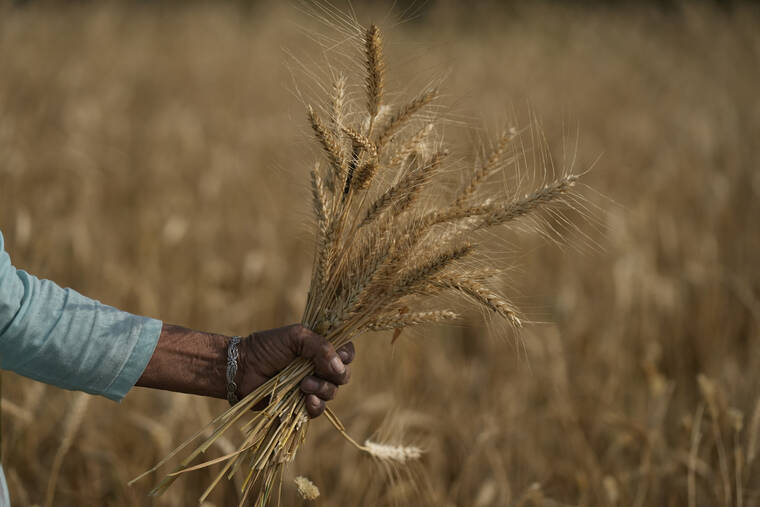Heatwave scorches India’s wheat crop and disrupts export plans
NEW DELHI >> An unusually early, record-breaking heatwave in India has reduced wheat yields and raised questions about how the country will balance its domestic needs with ambitions to boost exports and offset deficits stemming from Russia’s war in Ukraine.
Huge landfill sites in India’s capital, New Delhi, have caught fire in recent weeks. Schools in east India’s Odisha state have been closed for a week and in neighboring West Bengal, schools are stocking up on children’s oral rehydration salts. On Tuesday, Rajgarh, a city of over 1.5 million people in central India, was the hottest in the country, with daily highs of 46.5 degrees Celsius (114.08 Fahrenheit). Temperatures exceeded 45 degrees in nine other cities.
But it was the heat of March – the hottest in India on record in 1901 – that stunted the crops. Wheat is very sensitive to heat, especially in the final stages when its grains mature and ripen. Indian farmers plan their planting season to coincide with India’s typically cooler spring.
Climate change has made India’s heatwave hotter, said Friederike Otto, a climate scientist at Imperial College of London. She said before human activities increased global temperatures, heatwaves like this year’s would have hit India once every half century or so.
“But now it’s a much more frequent event — we can expect such high temperatures about every four years,” she said.
According to a 2021 report by the medical journal The Lancet, India’s vulnerability to extreme heat increased by 15% from 1990 to 2019. It is among the top 5 countries where vulnerable people such as the elderly and poor are most exposed to heat. It and Brazil have the highest heat-related mortality rates in the world, the report said.
Farm workers like Baldev Singh are among the most vulnerable. Singh, a farmer in Sangrur, in the northern Indian state of Punjab, watched as his crops dwindled before his eyes as a normally cool spring quickly turned to unrelenting heat. He lost about a fifth of his yield. Others lost more.
“I’m afraid the worst is yet to come,” Singh said.
Punjab is India’s “grain bowl” and the government has encouraged the cultivation of wheat and rice here since the 1960s. It’s typically the largest contributor to India’s national reserves, and the government had hoped to buy about a third of this year’s stocks from the region. But government estimates are predicting lower yields this year, and Devinder Sharma, an agricultural policy expert in the northern city of Chandigarh. said he expects to get 25% less.
The story is the same in other major wheat producing states like Uttar Pradesh and Madhya Pradesh.
In total, India bought over 43 million tonnes (47.3 million US tonnes) of wheat in 2021. Sharma estimates it will get 20% to almost 50% less instead.
Despite being the second largest wheat producer in the world, India exports only a small portion of its harvest. It had sought to capitalize on the global disruption in wheat supplies caused by Russia’s war in Ukraine and to find new markets for its wheat in Europe, Africa and Asia.
This seems uncertain given the difficult balance the government must maintain between supply and demand. It requires about 25 million metric tons (27.5 million US tons) of wheat for the extensive feeding program that typically feeds more than 80 million people.
Before the pandemic, India had vast supplies that far exceeded its domestic needs – a buffer against the risk of famine.
Those reserves have been strained by the distribution of free grain to about 800 million people — vulnerable groups like migrant workers — during the pandemic, Sharma said. The program has been extended through September, but it’s unclear if it will continue beyond that.
“We don’t have that kind of surplus anymore… now that exports are picking up, there would be a lot of pressure on the domestic availability of wheat,” Sharma said.
India’s federal ministries of agriculture and trade did not respond to questions emailed to them.
Besides India, other countries are also struggling with poor harvests preventing them from making up for potential supply shortages from Russia and Ukraine, which are typically the world’s top and fifth-largest wheat exporters.
China’s Agriculture Minister Tang Renjian said last month that the winter wheat harvest is likely to be poor, hampered by flooding and delays in sowing.


Comments are closed.